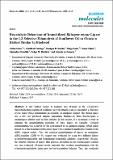Por favor, use este identificador para citar o enlazar a este item:
http://hdl.handle.net/10261/130930COMPARTIR / EXPORTAR:
 SHARE SHARE
 CORE
BASE CORE
BASE
|
|
| Visualizar otros formatos: MARC | Dublin Core | RDF | ORE | MODS | METS | DIDL | DATACITE | |

| Campo DC | Valor | Lengua/Idioma |
|---|---|---|
| dc.contributor.author | Luna, Carlos | - |
| dc.contributor.author | Verdugo, Cristóbal | - |
| dc.contributor.author | Sancho, Enrique D. | - |
| dc.contributor.author | Luna, Diego | - |
| dc.contributor.author | Calero, Juan | - |
| dc.contributor.author | Posadillo, Alejandro | - |
| dc.contributor.author | Bautista, Felipa M. | - |
| dc.contributor.author | Romero, Antonio A. | - |
| dc.date.accessioned | 2016-04-11T07:28:11Z | - |
| dc.date.available | 2016-04-11T07:28:11Z | - |
| dc.date.issued | 2014-08-04 | - |
| dc.identifier | issn: 1420-3049 | - |
| dc.identifier.citation | Molecules 19: 11419-11439 (2014) | - |
| dc.identifier.uri | http://hdl.handle.net/10261/130930 | - |
| dc.description.abstract | A new biofuel similar to biodiesel was obtained in the 1,3-selective transesterification reaction of sunflower oil with ethanol using as biocatalyst a Rhizopus oryzae lipase (ROL) immobilized on Sepiolite, an inorganic support. The studied lipase was a low cost powdered enzyme preparation, Biolipase-R, from Biocon-Spain, a multipurpose additive used in food industry. In this respect, it is developed a study to optimize the immobilization procedure of these lipases on Sepiolite. Covalent immobilization was achieved by the development of an inorganic-organic hybrid linker formed by a functionalized hydrocarbon chain with a pendant benzaldehyde, bonded to the AlPO4 support surface. Thus, the covalent immobilization of lipases on amorphous AlPO 4/sepiolite (20/80 wt %) support was evaluated by using two different linkers (p-hydroxybenzaldehyde and benzylamine-terephthalic aldehyde, respectively). Besides, the catalytic behavior of lipases after physical adsorption on the demineralized sepiolite was also evaluated. Obtained results indicated that covalent immobilization with the p-hydroxybenzaldehyde linker gave the best biocatalytic behavior. Thus, this covalently immobilized lipase showed a remarkable stability as well as an excellent capacity of reutilization (more than five successive reuses) without a significant loss of its initial catalytic activity. This could allow a more efficient fabrication of biodiesel minimizing the glycerol waste production. © 2014 by the authors. | - |
| dc.description.sponsorship | Grants from the Spanish Ministry of Economy and Competitiveness (Project ENE 2011-27017), Spanish Ministry of Education and Science (Projects CTQ2010-18126 and CTQ2011-28954-C02-02), FEDER funds and Junta de Andalucía FQM 0191, PO8-RMN-03515 and P11-TEP-7723 are gratefully acknowledged by the authors. We are also gratefully to Biocon®-Spain, for the kindly supply of the BIOLIPASE-R®. We acknowledge support by the CSIC Open Access Publication Initiative through its Unit of Information Resources for Research (URICI) | - |
| dc.publisher | Molecular Diversity Preservation International | - |
| dc.relation.isversionof | Publisher's version | - |
| dc.rights | openAccess | - |
| dc.subject | demineralized sepiolite | - |
| dc.subject | Biodiesel | - |
| dc.subject | immobilization | - |
| dc.subject | Rhizopus oryzae lipase | - |
| dc.subject | Biolipase-R | - |
| dc.subject | amorphous AlPO4/sepiolite | - |
| dc.subject | selective transesterification | - |
| dc.subject | monoglyceride | - |
| dc.subject | Ecodiesel | - |
| dc.subject | sunflower oil | - |
| dc.title | Biocatalytic behaviour of immobilized Rhizopus oryzae lipase in the 1,3-selective ethanolysis of sunflower oil to obtain a biofuel similar to biodiesel | - |
| dc.type | artículo | - |
| dc.identifier.doi | 10.3390/molecules190811419 | - |
| dc.relation.publisherversion | http://dx.doi.org/10.3390/molecules190811419 | - |
| dc.date.updated | 2016-04-11T07:28:12Z | - |
| dc.description.version | Peer Reviewed | - |
| dc.language.rfc3066 | eng | - |
| dc.rights.license | http://creativecommons.org/licenses/by/3.0/ | - |
| dc.contributor.funder | Ministerio de Economía y Competitividad (España) | - |
| dc.contributor.funder | Ministerio de Educación y Ciencia (España) | - |
| dc.contributor.funder | European Commission | - |
| dc.contributor.funder | Junta de Andalucía | - |
| dc.contributor.funder | Consejo Superior de Investigaciones Científicas (España) | - |
| dc.relation.csic | Sí | - |
| dc.identifier.funder | http://dx.doi.org/10.13039/501100003329 | es_ES |
| dc.identifier.funder | http://dx.doi.org/10.13039/501100000780 | es_ES |
| dc.identifier.funder | http://dx.doi.org/10.13039/501100003339 | es_ES |
| dc.identifier.funder | http://dx.doi.org/10.13039/501100011011 | es_ES |
| dc.identifier.pmid | 25093983 | - |
| dc.type.coar | http://purl.org/coar/resource_type/c_6501 | es_ES |
| item.fulltext | With Fulltext | - |
| item.openairecristype | http://purl.org/coar/resource_type/c_18cf | - |
| item.openairetype | artículo | - |
| item.cerifentitytype | Publications | - |
| item.grantfulltext | open | - |
| Aparece en las colecciones: | (IACT) Artículos | |
Ficheros en este ítem:
| Fichero | Descripción | Tamaño | Formato | |
|---|---|---|---|---|
| Biocatalytic_Behaviour_Luna.pdf | 1,25 MB | Adobe PDF |  Visualizar/Abrir |
CORE Recommender
PubMed Central
Citations
4
checked on 21-abr-2024
SCOPUSTM
Citations
23
checked on 23-abr-2024
WEB OF SCIENCETM
Citations
23
checked on 25-feb-2024
Page view(s)
293
checked on 24-abr-2024
Download(s)
281
checked on 24-abr-2024

